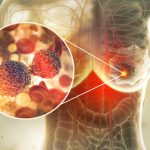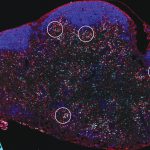Our cells are in a constant struggle of life and death – and, when things go smoothly, that balance is maintained and we don’t have to think about what our cells are doing to keep us alive.
But in some cases – such as asthma – this balance can go awry.
A research team led by University of Pittsburgh Graduate School of Public Health scientists reports in PNAS, the Proceedings of the National Academy of Science, their discovery of the intersection of two distinct, but also linked, biological signaling pathways that appear to become imbalanced in people with one of the most common types of asthma.

Sally Wenzel, M.D.
By knowing the critical nature of these intersecting pathways to life and death, the scientists believe that it may be possible to correct – or even prevent – this imbalance, stopping asthma attacks in their tracks.
“This combined imbalance of metabolically linked cell death and survival pathways is intriguing and suggests asthmatic epithelial cells – the primary cells interfacing with the patient’s lungs and the environment – are very ‘stressed out’ on a daily basis,” said senior author Dr. Sally Wenzel, chair of Pitt Public Health’s Department of Environmental and Occupational Health, and director of Pitt’s Asthma Institute at UPMC. “When the balance is disturbed, asthma exacerbations, or attacks, could then occur. I’m convinced understanding this pathway is key to developing both preventive medications for people with Type 2 asthma, the most common type of asthma, as well as treatments targeted to asthma exacerbations.”

When these stressed-out asthma epithelial cells are further irritated by viruses, allergens or pollutants, cell death can ensue, weakening the epithelial cells and potentially increasing inflammation. In some people with asthma, this can trigger an asthma attack.
For several years, Wenzel and her colleagues have investigated the role of ferroptosis – a specific kind of cell death – in various biological processes, but particularly in patients with Type 2 asthma. However, her team found that, despite evidence of ferroptosis, little cell death was occurring. Interestingly, they also observed activation of an ancient cell survival pathway, known as autophagy. Autophagy typically occurs in stressed cells and contributes to preservation of key components of these cells, including mitochondria, thereby promoting cell survival.
To the team’s surprise, a protein called PEBP1 that is key to activating ferroptosis when it binds with another protein called 15 LO1, also tightly regulates cell survival, or autophagy. Under common Type 2 asthma conditions, 15 LO1 increases and interacts with PEBP1 to facilitate ferroptosis, while simultaneously activating a different biological process that encourages autophagy in a compensatory pro-survival manner. All of this contributes to the stressed state of epithelial cells.
Thus, the researchers found that in Type 2 asthma, too much 15 LO1 protein leads to increased ferroptosis, while simultaneously inducing autophagy.

Wenzel believes that developing medications that inhibit 15LO1, specifically in the presence of PEBP1, could restore balance to the cells and limit their likelihood of dying a ferroptotic death.
“This type of drug could be an enzymatic inhibitor given as an inhaled medication or a pill,” said Wenzel. “It could prevent asthma attacks from starting, or even be used as a rescue medication to stop an asthma attack that is underway. Right now there are no medications that stop an asthma attack, only those that limit them. I’m eager to explore these options and hopefully find better medications for my patients.”









